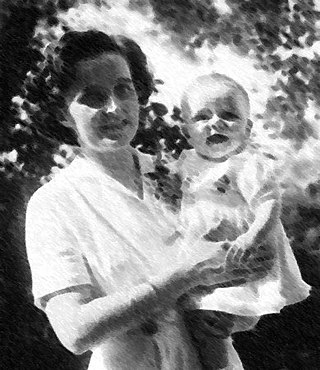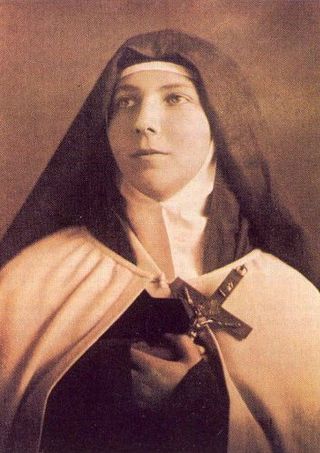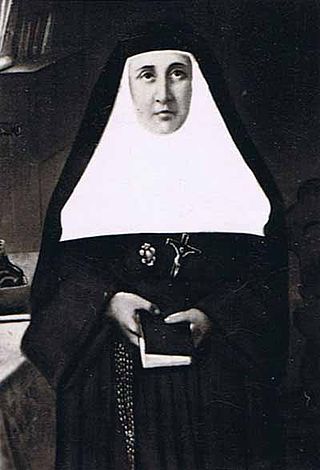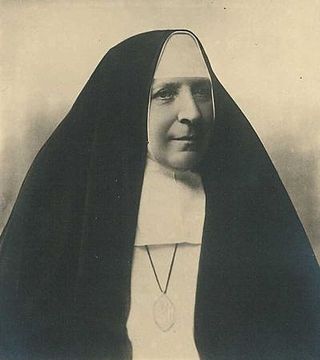
Gianna Beretta Molla was an Italian Roman Catholic pediatrician. Although aware of the fatal consequences, Molla refused both a termination of pregnancy and a hysterectomy during her pregnancy with her fourth child. Molla's medical career followed the teachings of the Roman Catholic Church; she believed in following her conscience while coming to the aid of others who required assistance. Molla also dedicated herself to charitable work amongst the elderly and was involved in Catholic Action; she also aided the Saint Vincent de Paul group in their outreach to the poor and less fortunate.

Teresa of Jesus of Los Andes, born as Juana Enriqueta Josephina de Los Sagrados Corazones Fernández Solar, was a Chilean nun of the Discalced Carmelites. Fernández Solar was a pious child but had an often unpredictable temperament for she could be prone to anger and being vain but could also demonstrate her charitable and loving nature; she seemed transformed when she decided to become a nun and her character seemed to change for her sole ambition was to dedicate herself to the service of God. But her time in the convent was cut short due to her contracting an aggressive disease that killed her - she knew she would die but was consoled knowing she would be able to make her profession before she died.

Candelaria de San José was a Venezuelan religious sister and the founder of the Carmelite Sisters of Venezuela - also known as the Carmelites of Mother Candelaria. The death of her parents in 1870 and 1887 prompted her to assume household responsibilities though in 1900 set her heart on aiding others in her area; this started in 1903 when she served as the director of a new hospital though she also tended to ill people during epidemics and conflicts that broke out over time.

José Olallo Valdés, OH was a Cuban professed religious and a professed member from the Brothers Hospitallers of Saint John of God. Olallo was dubbed as the "Poor People's Priest" even though Olallo was not an ordained priest - he was even encouraged to become one but refused. Olallo served as a nurse for his entire life and dedicated himself to the care of the ill and the poor and remained a pivotal figure in the hospital that he worked at.

Maria Candida of the Eucharist was an Italian Roman Catholic professed religious of the Discalced Carmelites. Barba desired to become a professed religious in her adolescence but her parents forbade this and she was forced to wait two decades to realize her dream; she entered the order after her parents died, though she alienated her brothers in the process. They refused to ever see her due to their resentment of her decision. Barba became a noted member of her convent in Ragusa and she served as prioress for an extensive period in which she fostered a rigid adherence to the order's rule so as to live the fullness of its charism. Her devotion to the Eucharist was a focal point for her spiritual thinking and her own life and she wrote to an extensive degree on the Eucharist and its importance.

Cecilia Eusepi was an Italian Roman Catholic and a professed member from the Secular Servites. Eusepi died of tuberculosis at 18 years of age, but only after her confessor advised her to keep a journal of her own life, which she titled Storia di un Pagliaccio, for she considered herself to be a "little clown" and "a half-stupid clown good for nothing"; she wrote that it must be her extreme weakness that appealed to God.
Maria Schininà, also known by her religious name Maria of the Sacred Heart of Jesus, was an Italian Roman Catholic nun and the founder of the Sisters of the Sacred Heart of Jesus (1889). Her adolescence demonstrated no particular spiritual emphasis though the death of her father and the marriage of her brother prompted a sudden inner conversion that saw her reach out and collaborate with the ill and the poor; she began in 1885 the foundations for what would become the religious congregation that she set up in 1889.

Blessed María Pilar López de Maturana Ortiz de Zárate, also known by her religious name Margarita María, was a Spanish Roman Catholic professed religious and the founder of the Mercedarian Missionaries of Bérriz. The religious made several international trips in order to serve in the missions as her order often dabbled in and undertook these trips despite a serious ulcer that transcended into stomach cancer but nevertheless she continued to promote the charism of the missions.
Blessed Bruna Pellesi, known as Maria Rosa of Jesus, was an Italian nun who was a member of the Franciscan Missionary Sisters of Christ. Pellesi served as an educator in places such as Sassuolo until she contracted tuberculosis and was moved to various sanatoriums for recuperation until the end of her life when she died in her convent.

María de las Maravillas de Jesús, OCD, in some contexts known as Maravillas de Jesús, was a Spanish Discalced Carmelite. She founded several houses of her order and even set one up in India after serving a brief exile with other Carmelites due to the outbreak of the Spanish Civil War.

Blessed Maria Teresa of Saint Joseph, DCJ, was a German religious sister and the founder of the Carmelite Daughters of the Divine Heart of Jesus. Tauscher worked in Cologne and was removed from her position after she converted to Roman Catholicism in 1888 so founded a congregation in the Netherlands upon choosing the Carmelite charism for her life.

Assunta Marchetti was an Italian Roman Catholic religious sister and the co-founder of the Missionary Sisters of Saint Charles Borromeo Scalabrinians; she worked in Brazil from 1895 until her death. She has been beatified as a Blessed Mother. Her priest brother Giuseppe is titled as Venerable on the path to sainthood.

Maria Karłowska – in religious Maria of Jesus Crucified – was a Polish Roman Catholic professed religious and the founder of the Sisters of the Divine Shepherd of Divine Providence. Karłowska worked with poor and abandoned people with an emphasis on girls and also tried to aid prostitutes avoid such a life and build another kind of life so used her order to reach out to such people to render assistance.

Enrichetta Alfieri, born Maria Angela Domenica Alfieri, was an Italian Roman Catholic religious sister and a member of the Sisters of Divine Charity.

María Rafols Bruna was a Spanish Roman Catholic nun, mystic and the co-founder of the Congregation of the Sisters of Charity of Saint Anne that she established alongside the Catholic priest Juan Bonal Cortada. María Rafols dedicated her entire life to the care of the ill working in hospitals in Zaragoza and during times of war risked her life to aid others. Internal complications and a range of outside interferences saw María Rafols be appointed to and resign from various leadership positions and she was captured – though later released – during the Carlist War.

Janina Szymkowiak - in religious Sancja - was a Polish Roman Catholic professed religious from the Daughters of the Sorrowful Mother of God. The nun studied foreign languages and literature before the outbreak that turned into World War II in which her convent was turned into a field hospital for prisoners of war as well as a place to do forced labor for the Nazi soldiers.

María del Carmen González-Ramos García-Prieto de Muñoz, also known by her religious name María del Carmen of the Child Jesus, was a Spanish Roman Catholic professed religious and the founder of the Franciscan Sisters of the Sacred Hearts. She married in mid-1857 – against her parents' advice – to a brash and dissolute husband and secured his repentance not too long before his death.
María Catalina Irigoyen Echegaray - in religious María Desposorios - was a Spanish Roman Catholic professed religious and a professed member from the Siervos de María Ministros de los Enfermos. From her adolescence she worked to comfort and tend to the old and ill and her religious call manifested while doing this work; she entered the order where her work increased.

Clara Fey was a German Roman Catholic Nun and the founder of the Sisters of the Poor Child Jesus. Her life was dedicated to providing aid to the poor, with particular emphasis on education, first in Aachen and later in the Netherlands.
Vincenzina Cusmano was an Italian Roman Catholic professed religious from the Sisters Servants of the Poor. Her brother was Giacomo Cusmano; she joined his religious congregation as the two tended to the poor in Palermo. Her original intention was to become a cloistered Carmelite nun though was forced to abandon this desire after her mother died; her mother's death during an epidemic meant that she had to assume care for her siblings since she was the eldest one. Cusmano tended to the poor in Palermo and often worked alongside her brother in this venture until his death in 1888; she continued his work as the Superior General for her order until her own death.
















